Leica M7
 | |
| Type | 35 mm camera |
|---|---|
| Lens mount | Leica M-mount |
| Focus | manual |
| Exposure | Av, manual |
| Flash | hot shoe |
The Leica M7 is a 35 mm camera by Leica AG introduced in 2002, the direct successor to the M6. The electronic Leica M7 is a departure from previous mechanical designs for the M series.
The M7 introduces auto-exposure in aperture priority mode: the user sets the aperture on the lens manually, and the camera will choose a shutter speed. Manual exposure is also available. The shutter is electronically controlled, but speeds of 1/60th and 1/125th of a second are mechanically governed if the battery fails. Like the M6 TTL, the M7 features an "off" position on the shutter speed dial. The shutter release is redesigned with two distinct levels of pressure: the first detent locks the exposure reading, the second fires the shutter.
The M7 is also the first Leica M series to support film DX encoding and exposure compensation using the dial that has been on the back of Leica cameras since the M3. Originally used simply as a reminder of the sensitivity of the film, and then as film speed setting coupled to the lightmeter starting with the M6, the dial now controls exposure compensation on the M7.
The M7 offers viewfinders with magnifications 0.58, 0.72 (28mm) and 0.85 (35mm). The viewfinder optics are multicoated to reduce flare.
In popular culture
The Leica M7 plays a key role in the movie EuroTrip. It also plays an important role in the movie Ted
-

Leica M7 in black chrome
External links
| Wikimedia Commons has media related to Leica M7. |
| ||||||||